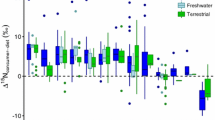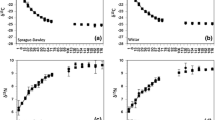Abstract
Ecologists conduct isotopic incorporation experiments to determine the residence time of various stable isotopes in animal tissues. These experiments permit determining the time window through which isotopic ecologists perceive the course of diet changes, and therefore the scale of the inferences that we can make from isotopic data. Until recently, the results of these experiments were analyzed using first-order, one-compartment models. Cerling et al. (Oecologia 151:175–189, 2007) proposed an approach they named the reaction progress variable to: (1) determine how many compartments are needed to describe a pattern of istopic incorporation, and (2) to estimate the size and rate constant of each pool. We elaborate on the approach described by Cerling et al. (Oecologia 151:175–189, 2007) by providing a way to estimate average retention times for an isotope in a tissue (and its associate error) for multi-compartment models. We also qualify the interpretation of the parameters in multi-compartment models by showing that many possible mechanisms yield models with the same functional form. Multi-compartment models are phenomenological, rather than mechanistic descriptions, of incorporation data. Finally, we propose the use of information theoretic criteria to assess the number of compartments that must be included in models of isotopic incorporation.


Similar content being viewed by others
References
Anderson DR, Burnham KP (2001) Commentary on models in ecology. Bull Ecol Soc Am 82:160–161
Ayliffe LK, Cerling TE, Robinson T, West AG, Sponheimer M, Passey BH, Hammer J, Roeder B, Dearing MD, Ehleringer JR (2004) Turnover of carbon isotopes in tail hair and breath CO2 of horses fed an isotopically varied diet. Oecologia 139:11–22
Bates DM, Watts DG (1988) Nonlinear regression and applications. Wiley, New York
Burnham KP, Anderson DR (2002) Model selection and multimodel inference. Springer, New York
Carleton SA, Martínez del Rio C (2005) The effect of cold-induced increased metabolic rate on the rate of 13C and 15N incorporation in house sparrows (Passer domesticus). Oecologia 144:226–232
Cerling TE, Ayliffe LK, Dearing MD, Ehleringer JR, B. Passey BH, Podlesack DW, A. Torregrossa A, West AG (2007a) Determining biological tissue turnover using stable isotopes: the reaction progress variable. Oecologia 151:175–189
Cerling TE, Bowen GJ, Ehleringer JR, Sponheimer M (2007b) The rection progress variable and isotope turnover in biological systems. In: Dawson TE, Siegwolf RTW (eds) Stable isotopes as indicators of ecological change. Academic Press, New York
Criss RE (1999) Principles of stable isotope distribution. Oxford University Press, New York
DeNiro MJ, Epstein S (1978) Influence of diet on the distribution of carbon isotopes in animals. Geochim Cosmochim Acta 42:495–506
DeNiro MJ, Epstein S (1981) Influence of diet on the distribution of nitrogen isotopes in animals. Geochim Cosmochim Acta 45:341–351
Ette EI, Williams PJ, Kim YH, Lane JR, Liu M, Cappareli EV (2003) Model appropriateness and population pharmacokinetic modeling. J Clin Pharmacol 43:610–623
Fleishaker JC, Smith RB (1987) Compartment model analysis in pharmacokinetics. J Clin Pharmacol 27:922–926
Gibaldi M, An D. Peerier (1982) Pharmacokinetics. Dekker, New York
Harte J (1985) Consider a spherical cow: a course in environmental problem solving. Kaufmann, Los Altos
Hobbs TN, Hilborn R (2006) Alternatives to statistical hypothesis testing in ecology: a guide to self-teaching. Ecol Appl 16:5–19
Hobson KA (1993) Trophic relationships among high Arctic sabirds: insights from tissue-dependent stable-isotope models. Mar Ecol Prog Ser 95:7–18
Hobson KA, Clark RG (1992) Assessing avian diets using stable isotopes I: turnover of 13C in tissues. Condor 94:181–188
Martínez del Rio C, Wolf BO (2005) Mass-balance models for animal-isotopic ecology. In: Starck M, Wang T (eds) Physiological and ecological adaptations to feeding in vertebrates. Science Publishers, Enfield
Motulsky HJ, Christopoulos A (2004) Fitting models to biological data using linear and non-linear regression: a practical guide to curve fitting. Oxford University Press, Oxford
Motulsky HJ, Ransnas LA (1987) Fitting curves to data using non-linear regression: a practical and non-mathematical review. FASEB J 1:365–374
Newsome SD, Martínez del Rio C, Phillips DL, Bearhop S (2007) A niche for isotopic ecology. Front Ecol Environ 5:429–436
Norris DR, Marra PP, Kyser TK, Sherry TW, Ratcliffe TM (2004) Tropical winter habitat limits reproductive success on the temperate breeding grounds in a migratory bird. Proc R Soc Lond B Biol Sci 271:59–64
O’Brien DM, Schrag DP, Martínez del Rio C (2000) Allocation to reproduction in a hawkmoth: a quantitative analysis using stable isotopes. Ecology 81:2822–2831
Phillips DL, Eldrige PM (2006) Estimating the timing of diet shifts using stable isotopes. Oecologia 147:195–203
Phillips DL, Gregg JW (2003) Source partitioning using stable isotopes: coping with too many sources. Oeologia 136: 261-269
Shargel L, Yu BCA (1999) Applied biopharmaceutics and pharmacokinetics. McGraw Hill, New York
Stephens PA, Buskirk SW, Martinez del Rio C (2007) Inference in ecology and evolution. Trends Ecol Evol 22:192–197
Stuart A, Ord JK (1994) Kendall’s advance theory of statistics. Distribution theory, vol 1. Arnold, London
Tieszen LL, Boutton TW, Tesdahl KG, Slade NA (1983) Fractionation and turnover of stable carbon isotopes in animal tissues: implications for δ13C analysis of diet. Oecologia 57:32–37
Waterlow JC (2006) Protein turnover. CABI International, Cambridge
Acknowledgements
Seth Newsome gave us useful comments. We are grateful to Thure Cerling for developing the reaction progress variable and for comments on drafts of this manuscript. Martínez del Rio was supported by NSF grant ISBN (0421738). The experiments reported here were approved by the University of Wyoming Institutional Animal Care Committee and were conducted by Scott Carleton.
Author information
Authors and Affiliations
Corresponding author
Additional information
Communicated by Mark Chappell.
Appendix 1 A variance estimate for \( {\hat{\bar{\tau}}} \)
Appendix 1 A variance estimate for \( {\hat{\bar{\tau}}} \)
We derive our results for the k-compartment model using the parameterization:
Estimation of this form with 2k − 1, instead of 2k parameters results in a non-singular estimate of its variance covariance, V, but estimates should incorporate the restriction that forces 0 ≤ p i < 1 for all i, and \( \sum_i {p_i = 1.} \) For the k compartment, the average retention time is:
Applying the multivariate delta method, we pre- and post-multiply V by the vector of first partial derivatives:
The dimensions of V force this result to be a scalar. The components of the partial derivative vectors are:
In the case of k = 2, the variance reduces to:
Most non-linear regression programs include V in their output.
Rights and permissions
About this article
Cite this article
Martínez del Rio, C., Anderson-Sprecher, R. Beyond the reaction progress variable: the meaning and significance of isotopic incorporation data. Oecologia 156, 765–772 (2008). https://doi.org/10.1007/s00442-008-1040-z
Received:
Accepted:
Published:
Issue Date:
DOI: https://doi.org/10.1007/s00442-008-1040-z




